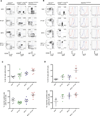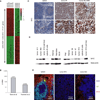Synergy between PI3K signaling and MYC in Burkitt lymphomagenesis
- PMID: 22897848
- PMCID: PMC3432451
- DOI: 10.1016/j.ccr.2012.06.012
Synergy between PI3K signaling and MYC in Burkitt lymphomagenesis
Abstract
In Burkitt lymphoma (BL), a germinal center B-cell-derived tumor, the pro-apoptotic properties of c-MYC must be counterbalanced. Predicting that survival signals would be delivered by phosphoinositide-3-kinase (PI3K), a major survival determinant in mature B cells, we indeed found that combining constitutive c-MYC expression and PI3K activity in germinal center B cells of the mouse led to BL-like tumors, which fully phenocopy human BL with regard to histology, surface and other markers, and gene expression profile. The tumors also accumulate tertiary mutational events, some of which are recurrent in the human disease. These results and our finding of recurrent PI3K pathway activation in human BL indicate that deregulated c-MYC and PI3K activity cooperate in BL pathogenesis.
Copyright © 2012 Elsevier Inc. All rights reserved.
Figures







Comment in
-
Burkitt lymphoma: much more than MYC.Cancer Cell. 2012 Aug 14;22(2):141-2. doi: 10.1016/j.ccr.2012.07.018. Cancer Cell. 2012. PMID: 22897844
-
Targeted therapies: New targets in Burkitt lymphoma?Nat Rev Clin Oncol. 2012 Oct;9(10):551. doi: 10.1038/nrclinonc.2012.153. Epub 2012 Aug 28. Nat Rev Clin Oncol. 2012. PMID: 22926023 No abstract available.
Similar articles
-
Burkitt lymphomagenesis linked to MYC plus PI3K in germinal center B cells.Oncotarget. 2012 Oct;3(10):1066-7. doi: 10.18632/oncotarget.726. Oncotarget. 2012. PMID: 23164662 Free PMC article. No abstract available.
-
Nuclear FOXO1 promotes lymphomagenesis in germinal center B cells.Blood. 2018 Dec 20;132(25):2670-2683. doi: 10.1182/blood-2018-06-856203. Epub 2018 Oct 17. Blood. 2018. PMID: 30333121
-
Burkitt lymphoma: much more than MYC.Cancer Cell. 2012 Aug 14;22(2):141-2. doi: 10.1016/j.ccr.2012.07.018. Cancer Cell. 2012. PMID: 22897844
-
Impact of MYC on malignant behavior.Hematology Am Soc Hematol Educ Program. 2014 Dec 5;2014(1):100-6. doi: 10.1182/asheducation-2014.1.100. Epub 2014 Nov 18. Hematology Am Soc Hematol Educ Program. 2014. PMID: 25696841 Review.
-
Oncogenic mechanisms in Burkitt lymphoma.Cold Spring Harb Perspect Med. 2014 Feb 1;4(2):a014282. doi: 10.1101/cshperspect.a014282. Cold Spring Harb Perspect Med. 2014. PMID: 24492847 Free PMC article. Review.
Cited by
-
The case of the missing c-Myc.Nat Immunol. 2012 Nov;13(11):1029-31. doi: 10.1038/ni.2455. Nat Immunol. 2012. PMID: 23080195 No abstract available.
-
Base-pair resolution DNA methylome of the EBV-positive Endemic Burkitt lymphoma cell line DAUDI determined by SOLiD bisulfite-sequencing.Leukemia. 2013 Aug;27(8):1751-3. doi: 10.1038/leu.2013.4. Epub 2013 Jan 11. Leukemia. 2013. PMID: 23307032 Free PMC article. No abstract available.
-
The complex pathophysiology of acquired aplastic anaemia.Clin Exp Immunol. 2015 Jun;180(3):361-70. doi: 10.1111/cei.12605. Epub 2015 Apr 23. Clin Exp Immunol. 2015. PMID: 25683099 Free PMC article. Review.
-
Recurrent mutation of the ID3 gene in Burkitt lymphoma identified by integrated genome, exome and transcriptome sequencing.Nat Genet. 2012 Dec;44(12):1316-20. doi: 10.1038/ng.2469. Epub 2012 Nov 11. Nat Genet. 2012. PMID: 23143595
-
Identification of clinical molecular targets for childhood Burkitt lymphoma.Transl Oncol. 2020 Dec;13(12):100855. doi: 10.1016/j.tranon.2020.100855. Epub 2020 Sep 15. Transl Oncol. 2020. PMID: 32947237 Free PMC article.
References
-
- Adams JM, Cory S. Myc oncogene activation in B and T lymphoid tumours. Proc. R. Soc. Lond. B Biol. Sci. 1985;226:59–72. - PubMed
-
- Alizadeh AA, Eisen MB, Davis RE, Ma C, Lossos IS, Rosenwald A, Boldrick JC, Sabet H, Tran T, Yu X, et al. Distinct types of diffuse large B-cell lymphoma identified by gene expression profiling. Nature. 2000;403:503–511. - PubMed
-
- Bengtsson H, Irizarry R, Carvalho B, Speed TP. Estimation and assessment of raw copy numbers at the single locus level. Bioinformatics. 2008;24:759–767. - PubMed
-
- Bhatia KG, Gutiérrez MI, Huppi K, Siwarski D, Magrath IT. The pattern of p53 mutations in Burkitt’s lymphoma differs from that of solid tumors. Cancer Res. 1992;52:4273–4276. - PubMed
Publication types
MeSH terms
Substances
Associated data
- Actions
Grants and funding
LinkOut - more resources
Full Text Sources
Other Literature Sources
Molecular Biology Databases

